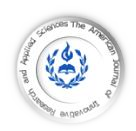
GENERAL INFORMATION
| HOME | ABOUT US | ARCHIVE | AIMS AND SCOP | AUTHORS | REVIEW | SUMIBMIT MANUSCRIPT | EDITORIAL BOARED | PUBLICATION FEE |

| HOME || ABOUT US || ARCHIVES || AIMS AND SCOP || AUTHORS || REVIEW|| SUBMIT MANUSCRIPT || EDITORIAL BOARD |

| Info-AJIRAS-® Journal ISSN 2429-5396 (Online) / Reference CIF/15/0289M |
American Journal of Innovative Research & Applied Sciences

|
American Journal of innovative
Research & Applied Sciences
Research & Applied Sciences
ISSN 2429-5396 (Online)
OCLC Number: 920041286
OCLC Number: 920041286

Authors Contact
*Correspondant author and authors Copyright © 2024:
| Mustapha Sidqui 1.2* | Oumaima Lachhab 1.2 | and | Mustapha Sidqui 1.2|
Affiliation.
1. Faculty of dentistry, Hassan II University | Casablanca | Morocco |
2. Rue Abou Alâa Zahr | Casablanca 21100 | Maroc |
This article is made freely available as part of this journal's Open Access:
| DOI: 10.5281/zenodo.10427760 |
*Correspondant author and authors Copyright © 2024:
| Mustapha Sidqui 1.2* | Oumaima Lachhab 1.2 | and | Mustapha Sidqui 1.2|
Affiliation.
1. Faculty of dentistry, Hassan II University | Casablanca | Morocco |
2. Rue Abou Alâa Zahr | Casablanca 21100 | Maroc |
This article is made freely available as part of this journal's Open Access:
| DOI: 10.5281/zenodo.10427760 |



| ISSN: 2429-5396 (e) | https://www.american-jiras.com | |
| Web Site Form: v 0.1.05 | JF 22 Cours, Wellington le Clairval, Lillebonne | France |
| Web Site Form: v 0.1.05 | JF 22 Cours, Wellington le Clairval, Lillebonne | France |
ABSTRACT
Introduction: Clinicians and scientists are actively pursuing diagnostic methodologies that are timely, cost-effective, accurate, and non-invasive. The early detection of pathology plays a crucial role in influencing patient discomfort, prognosis, therapeutic intervention, survival rates, and recurrence. However, traditional diagnostic methods often involve painful and invasive procedures, such as repeated biopsies and blood draws, contributing to patient stress during an already unpleasant experience. Objective: The objective of this study is to explore alternative diagnostic approaches that leverage saliva-based microbial, immunological, and molecular biomarkers. This investigation aims to assess the feasibility of using oral fluids to evaluate the health status of individuals, offering a non-invasive and patient-friendly alternative to traditional diagnostic methods. Methods: To achieve our objective, we conducted a comprehensive review of existing literature and research related to saliva-based diagnostics. We focused on exploring microbial, immunological, and molecular biomarkers present in saliva and their potential applications in diagnostic procedures. The research methodology involved an in-depth analysis of studies addressing the use of saliva for diagnostic purposes. Results: The findings reveal promising opportunities in the discovery of saliva-based biomarkers. These biomarkers provide unique insights into the health status of individuals and offer a non-invasive means of diagnosis. The results of our literature review suggest that saliva has the potential to serve as a valuable diagnostic fluid, presenting advantages over traditional invasive methods. Conclusion: In conclusion, the exploration of saliva-based microbial, immunological, and molecular biomarkers presents a compelling avenue for non-invasive diagnostics. Leveraging these biomarkers offers a potential paradigm shift in diagnostic procedures, reducing the need for invasive techniques that contribute to patient discomfort. The integration of saliva-based diagnostics into clinical practices, particularly in dentistry, holds the promise of improving patient experience and overall diagnostic efficacy.
Keywords: Saliva; Saliva Diagnostics; Saliva Test; Dentistry.
Introduction: Clinicians and scientists are actively pursuing diagnostic methodologies that are timely, cost-effective, accurate, and non-invasive. The early detection of pathology plays a crucial role in influencing patient discomfort, prognosis, therapeutic intervention, survival rates, and recurrence. However, traditional diagnostic methods often involve painful and invasive procedures, such as repeated biopsies and blood draws, contributing to patient stress during an already unpleasant experience. Objective: The objective of this study is to explore alternative diagnostic approaches that leverage saliva-based microbial, immunological, and molecular biomarkers. This investigation aims to assess the feasibility of using oral fluids to evaluate the health status of individuals, offering a non-invasive and patient-friendly alternative to traditional diagnostic methods. Methods: To achieve our objective, we conducted a comprehensive review of existing literature and research related to saliva-based diagnostics. We focused on exploring microbial, immunological, and molecular biomarkers present in saliva and their potential applications in diagnostic procedures. The research methodology involved an in-depth analysis of studies addressing the use of saliva for diagnostic purposes. Results: The findings reveal promising opportunities in the discovery of saliva-based biomarkers. These biomarkers provide unique insights into the health status of individuals and offer a non-invasive means of diagnosis. The results of our literature review suggest that saliva has the potential to serve as a valuable diagnostic fluid, presenting advantages over traditional invasive methods. Conclusion: In conclusion, the exploration of saliva-based microbial, immunological, and molecular biomarkers presents a compelling avenue for non-invasive diagnostics. Leveraging these biomarkers offers a potential paradigm shift in diagnostic procedures, reducing the need for invasive techniques that contribute to patient discomfort. The integration of saliva-based diagnostics into clinical practices, particularly in dentistry, holds the promise of improving patient experience and overall diagnostic efficacy.
Keywords: Saliva; Saliva Diagnostics; Saliva Test; Dentistry.
Abstarct7-December-2023

| JANUARY | VOLUME 18 | ISSUE N° 1 | 2024 |
| ARTICLES | Am. J. innov. res. appl. sci. Volume 18, Issue - 1 Pages 12-19 (January, 2024)
| ARTICLES | Am. J. innov. res. appl. sci. Volume 18, Issue - 1 Pages 12-19 (January, 2024)
ADVANCEMENTS IN SALIVARY BIOMARKERS: TRANSFORMING DIAGNOSTIC LANDSCAPE IN DENTISTRY
| Mustapha Sidqui 1.2* | Oumaima Lachhab 1.2 | and | Mustapha Sidqui 1.2|. Am. J. innov. res. appl. sci. 2024; 18(1):12-19. doi: 10.5281/zenodo.10427760
| PDF FULL TEXT | | XML FILE | | https://doi.org/10.5281/zenodo.10427760 |
| Mustapha Sidqui 1.2* | Oumaima Lachhab 1.2 | and | Mustapha Sidqui 1.2|. Am. J. innov. res. appl. sci. 2024; 18(1):12-19. doi: 10.5281/zenodo.10427760
| PDF FULL TEXT | | XML FILE | | https://doi.org/10.5281/zenodo.10427760 |